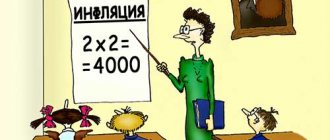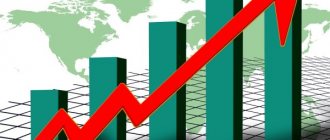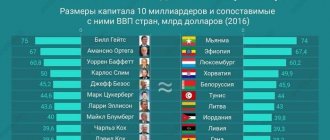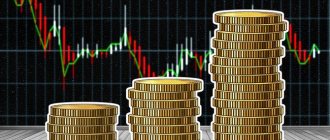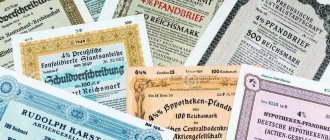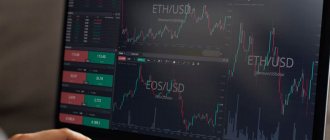olegas Jul 4, 2022 / 102 Views
This term comes from the English word value, translated into Russian, meaning cost, value. Revaluation is the antonym of the word devaluation and is applied to the national currency, characterizing the degree of increase in its purchasing power in relation to the currencies of other countries.
Revaluation is the process of increasing the exchange rate of one currency in relation to other world currencies or to gold.
Concept of revaluation
The term “revaluation” is very rarely mentioned in the media and other sources from which we get economic information. Probably because in Russia we have not yet observed this phenomenon and will not observe it in the near future. Let's talk about the reasons separately.
Don't be poor, learn to manage your money and increase it.
More about the course
Currency revaluation in the economy is an increase in the exchange rate of the national currency (in Russia - the ruble) in relation to foreign currencies or gold. It is one of the monetary policy instruments of central banks or other financial institutions in different countries (for example, the Federal Reserve in the USA).
When we see that for 1 $ today they give 65 rubles, and not 73, as it was yesterday, this will mean a revaluation of our national currency, i.e. its strengthening. The reverse process is called devaluation, which means a decrease in the value of the national currency in relation to foreign currencies. We should not confuse it with another phenomenon in the economy - deflation, by which we mean the reverse process of inflation, i.e. a decrease in the price level in the country.
A person who has little understanding of economic processes can only rejoice at the strengthening of the ruble and scold the government for its weakening, which is what we most often observe. But it is bad not only when the national currency is too strong, but also when it is too weak. Balance is always needed. Finding it is the main task of the financial body, which carries out monetary policy in the state. In Russia this is the Central Bank.
More than 100 cool lessons, tests and exercises for brain development
Start developing
Let's look at several historical examples of revaluation:
- Germany. The exchange rate strengthened in western Germany (FRG) in the late 60s against gold by 9%.
- China. The revaluation occurred at the time of the abandonment of the fixed exchange rate and the transition to a floating one in 2005. In one day, the Chinese yuan strengthened by 2%. The process lasted for several years. After 3 years, the yuan strengthened by 20%, by 2013 – by 27%.
- Switzerland. At first, it kept the exchange rate of the franc against the euro and the US dollar within certain limits. After the weakening of the euro in 2015, Switzerland abolished its peg, which caused a sharp strengthening of the franc by 30% in a few hours.
- Japan. It has always been an export-oriented country. Under US pressure, the yen strengthened, first in 1971, then from 1985 to 1988. As a result, exports fell and GDP declined.
Revaluation does not necessarily occur as a result of the actions of central banks or other financial institutions. This process can occur spontaneously under the influence of internal and external factors. For example, in Russia, the strengthening of the ruble always occurs against the backdrop of rising oil prices on the world market.
What does currency revaluation mean?
The integration and globalization of national open economic systems gives rise to purely market mechanisms: a country that has revalued its currency becomes unusually “expensive” and, accordingly, not so attractive to other states in every area of international cooperation. Increasing the value of a currency is the same as selling standard products at a market at a higher price than neighboring competitors. Therefore, they resort to this measure only as a last resort - in accordance with anti-inflationary policy.
Revaluation and devaluation are a consequence of inflation processes in the economy and imbalances in the balance of payments. But the latter can only be carried out in countries with a chronically active balance of payments. That is why different states repeatedly resorted to this measure in the second half of the 20th century: Germany, Switzerland, Japan.
Reasons for holding
Let's look at the reasons for the revaluation, that is, why the Central Bank can strengthen the ruble.
- Decrease in inflation
Let's say that to produce our products we need to purchase raw materials abroad, which are traded at $100 per unit. We receive revenue in rubles. Therefore, in order to buy imported goods, we must first exchange rubles for dollars. Today we did it for 70 rubles/$, i.e. we spent 7,000 rubles. per unit of imported raw materials.
Tomorrow the rate has changed, and for 1 $ they are asking for 73 rubles. We will spend 7,300 rubles. per unit of imported raw materials. Who will pay for this increase? Of course, the consumer, that is, you and me. Prices for products containing imported components will rise. Naturally, prices will increase for everything we buy with US dollars. This is inflation, the excessive growth of which is being fought in all countries of the world. Strengthening the ruble is one of the methods of struggle.
- Replenishment of foreign exchange reserves
The state can strengthen the national currency if it is necessary to replenish gold and foreign exchange reserves. In this case, it will buy dollars, euros or gold for fewer rubles than it would have at a higher rate.
- Increasing the share of imports
If the state is faced with the task of increasing the share of imports in the economy, then it can be solved by strengthening the national currency. Let's say you have two alternative goods: one from Russia, the other from Europe. Both are the same quality. If the ruble exchange rate depreciates against the euro, imported goods will cost you less in ruble equivalent. All other things being equal, you will buy it, and not the Russian analogue.
Who benefits and disadvantages from revaluation?
The answer to the question is more or less obvious. During periods of local currency appreciation, economic advantages arise for importers. After all, now it is profitable for them to produce goods at home for “cheap” currency, export them abroad and sell them there for “expensive” currency.
For this reason, many Russian entrepreneurs focus on sales to Europe and the USA. After all, they calculate the cost of goods in “cheap” rubles, and receive revenue in “expensive” dollars and euros.
And, conversely, currency revaluation is disadvantageous for local exporters. The growth of the national currency increases the cost of production. This means it raises the selling price for the end consumer abroad. I note that the pros and cons of revaluation apply only to manufacturing companies!
Ways to strengthen the national currency
When the currency was pegged to the price of gold (before the abolition of the Bretton Woods currency system in the 70s of the last century), in order for the exchange rate to rise, it was necessary to increase the country's gold reserves. After the abolition of the “gold standard”, the exchange rate became floating and depended on supply and demand on the market. To increase it, the Central Bank can use the following tools:
- Currency interventions are operations to buy or sell currency on the market. The essence of the mechanism: The Central Bank brings large volumes of foreign currency to the foreign exchange market in order to exchange it for rubles, increasing supply with this operation. And this, in turn, leads to a decrease in the price that we give for 1 US dollar or euro, i.e. the ruble strengthens.
- Reducing the dependence of budget revenues on the sale of the country's resources abroad. When dependence is high, a strong national currency is simply unprofitable for either the state budget or exporters. The received export proceeds must be converted into rubles, and at a low exchange rate the ruble amount will be less than at a high one.
- Creating a shortage of goods, the sale of which on the world market depends on replenishing the budget. For example, a reduction in oil production leads to a shortage of oil, and therefore to an increase in market prices. The ruble exchange rate will strengthen against the backdrop of rising oil prices. It is difficult for a country to use this method alone. We need to negotiate with other oil producers.
- Raising the key rate. The key rate reflects the cost of money for commercial banks, businesses and the public. The higher it is, the more expensive the money, and vice versa. Imagine that banks borrow from the Central Bank at a low interest rate. If the ruble exchange rate falls sharply, then instead of lending to businesses and the population, banks will begin to buy foreign currency. To stop this process, the Central Bank raises the key rate, i.e. increases the cost of money. Demand for currency is decreasing, the ruble is strengthening.
Who benefits from currency growth?
From the above, we can conclude that revaluation can be useful for the state’s economy only in certain aspects. For example, if it is necessary to stop the growth of inflation or to bring the balance of payments/trade balances into balance. But, in addition to certain benefits, this process can also bring quite significant harm, which was also discussed above.
We also know that as a result of revaluation, domestic producers suffer, in particular, those whose goods are export-oriented. However, for manufacturers and suppliers of imported products, the growth of the national currency is beneficial, since they will be able to buy it abroad at a favorable price and sell it within the state for a significantly increased currency.
Revaluation is also beneficial for ordinary citizens of the country. The population will be able to purchase many relatively cheap imported products. Moreover, domestic manufacturers will be forced to reduce prices. Also, citizens of the country will be able to purchase foreign currency at a more favorable exchange rate. Travel to foreign countries will become more accessible, since citizens will be able to extract more material benefits in a foreign country per unit of national currency.
And yet, it is important to remember that no matter how beneficial the exchange rate growth may seem for ordinary citizens, it can also have a negative impact on them. This is explained by the fact that if the economic situation within the state worsens, which can be caused by a significant increase in the currency, this will have an impact on the entire population of the country. Mainly due to the suppression of the activities of domestic companies by cheap imports, this will lead to a significant reduction in production volumes and, accordingly, the number of personnel. Left without work, the population will not be able to find the means to realize all the benefits that revaluation can give them.
It is worth noting that revaluation may be unprofitable only for enterprises that produce finished products. For companies that export and import raw materials, this procedure, like devaluation, does not have a significant impact.
What does Big Mac have to do with it?
The exchange rate of the national currency influences investment activity. But an investor cannot predict with 100% probability what to expect from the state: revaluation or devaluation. Some people use purchasing power parity methods. The most interesting of them is the calculation of the Big Mac index.
The idea is to compare the cost of a globally popular sandwich in different countries. For example, we want to determine how fair the ruble exchange rate is against the US dollar today. We charge the cost of a Big Mac in the USA and in our country. There is no need to do this yourself. Since 1986, the Big Mac Index has been published by The Economist magazine.
As of July 2022, the ruble is undervalued by 59.9%. A sandwich in Russia costs 169 rubles. and $5.65 in the US. The fair exchange rate is 29.9 rubles/$.
For 20 years (the magazine has been keeping statistics for Russia since April 2000), the ruble has never been among the overvalued currencies. The change in the level of undervaluation over 5 years is reflected in the table.
| Period | Level of undervaluation, % |
| July 2021 | 59,9 |
| January 2021 | 68 |
| July 2020 | 66,5 |
| January 2020 | 61,2 |
| July 2019 | 64,5 |
| January 2019 | 70,4 |
| July 2018 | 62 |
| January 2018 | 56,6 |
| July 2017 | 57 |
| January 2017 | 57,5 |
Example: Is the Canadian dollar being devalued or revalued?
Let us recall that over 22 years (1998-2020), the Canadian dollar “rose in price” by 11% against the American dollar. If you carefully examine the chart below for USD CAD on the MN timeframe, you will find many OTHER clarifying FACTS:
- the strongest revaluation (strengthening) of the Canadian dollar was from January 2002 to October 2007. (from 1.6197 to 0.9061) and amounted to almost 79% or 7129 exchange points. CAD was more expensive than its American “namesake” for half a year, and all the “serious” media of the world (from The Wall Street Journal and Reuters to RIA Novosti and Lenta.ru) explained the “pattern” and “logicality” of this revaluation, forcing millions of people in the world buy the Canadian dollar... at the very peak of its strengthening. Can you guess what happened next?
- since November 2007 and to this day there is a devaluation of the Canadian dollar , in which the currency pair has been in a rigid flat for 2 years between strong levels of order accumulation at 1.2830 and 1.3564.
- trading plan : breaking through and consolidating BEYOND the specified flat levels will lead to a strong bullish or bearish trend with the goals indicated in our figure.
- AO_ZOTIK - pay attention to how the Masterforex-V Academy’s proprietary indicator clearly shows the boundaries of devaluation and revaluation through its divergences.
Consequences
The consequences of revaluation for the economy and population can be positive and negative.
Positive:
- reduction of inflation, respectively, increase in the well-being of the population;
- increasing the attractiveness of imported goods for the population and business, therefore, increasing imports;
- stimulation of production in order to compete for consumers within the country;
- increasing the ability to replenish the country’s gold and foreign exchange reserves at a more favorable rate;
- increasing the attractiveness of investment instruments denominated in foreign currency, which is good for the investor, but bad for the state.
Negative:
- a decrease in budget revenues if it is largely dependent on export earnings, and this affects the state’s ability to finance social items;
- a decrease in exporters' revenue in ruble equivalent, which may negatively affect their activities and lead to a decrease in exports;
- cheap imports can push Russian enterprises out of the market if they cannot compete with it;
- the withdrawal of Russian capital into foreign assets, which could lead to a fall in the national stock market;
- the departure of foreign investors and tourists from the Russian market due to an unfavorable exchange rate.
What should an investor do?
The concept of revaluation for an investor means the opportunity to earn money. The possibility of losses is also not excluded.
As for investing directly in a currency when it strengthens, this is a risky move. Situations like the rise of the yen in the 70s and 80s are excluded, so earnings are unlikely to exceed 2-7% per year, provided that the rate continues to rise.
If you keep funds in a currency that has sharply strengthened, it is more profitable to transfer at least part of the money to the stock market, and buy shares for euros, dollars or another currency. This way, the investor will receive additional income due to the growth of the national currency.
Sustained revaluation is bad for the stock market . Companies become less competitive, sales fall, and with them the value of shares. If there are hints of a strengthening of the currency of any country, and you have invested in securities of local companies, it is better to play it safe and withdraw some of your capital from them.
There are exceptions to this rule. Thus, in China, the strengthening of the yuan in the 2000s did not lead to a drop in GDP; exports remained in demand.
When to expect the ruble to strengthen in Russia
The Russian budget continues to be heavily dependent on oil and gas revenues. According to the Ministry of Finance, we can see how the dependence has changed over the past 15 years.
| Years | Total revenues, billion rubles. | Including oil and gas, billion rubles. | Including oil and gas, % |
| 2006 | 6 278,9 | 2 943,5 | 46,88 |
| 2007 | 7 784,1 | 2 897,4 | 37,22 |
| 2008 | 9 275,9 | 4 389,4 | 47,32 |
| 2009 | 7 337,8 | 2 984,0 | 40,67 |
| 2010 | 8 305,4 | 3 830,7 | 46,12 |
| 2011 | 11 367,7 | 5 641,8 | 49,63 |
| 2012 | 12 855,5 | 6 453,2 | 50,20 |
| 2013 | 13 019,9 | 6 534,0 | 50,18 |
| 2014 | 14 496,9 | 7 433,8 | 51,28 |
| 2015 | 13 659,2 | 5 862,7 | 42,92 |
| 2016 | 13 460,0 | 4 844,0 | 35,99 |
| 2017 | 15 088,9 | 5 971,9 | 39,58 |
| 2018 | 19 454,4 | 9 017,8 | 46,35 |
| 2019 | 20 188,8 | 7 924,3 | 39,25 |
| 2020 | 18 719,1 | 5 235,2 | 27,97 |
Until 2016, almost half of the income was generated from the sale of the country’s energy resources. Since 2016, there has been a downward trend in the share, but it is still unstable. It is impossible to say that we have significantly weakened the dependence. This means that in the coming years we should not expect active actions by the Central Bank to strengthen the ruble. This is simply not profitable for our economy.
With a fall in world oil and gas prices, our budget will be seriously short of money. It can be replenished by depreciating the ruble, when, with a decrease in foreign exchange earnings in ruble equivalent, it can remain the same or even increase. Until we find other ways to replenish the budget, the ruble will fall, and the population will continue to get poorer.
How to identify currencies that are ALREADY ready for devaluation
According to the Masterforex-V trading system, trend reversals (from devaluation to revaluation or vice versa) are determined thanks to trend reversal patterns and patterns of its continuation, when one of the trend reversal patterns is formed at strong levels of accumulation of limit orders (respectively, resistance or support). This can be “head and shoulders”, triple and double top or bottom (shown in the example below), “diamond”, “spike”, “cup with handle”, etc. They can (when changing volumes - see green and red candles of the indicator) cause a trend change.
An example of a reversal of a bearish trend to a bullish one through a “double bottom” pattern , formed at the level of a large accumulation of buyer limit orders. Please note that the analysis of the volumes of “green” candles on buy significantly exceeds red candles on sell in the balance of market supply and demand.
Trend continuation patterns - flag or pennant, wedge, rectangles, triangles - symmetrical triangle, ascending and descending triangles, expanding triangle, gap (Gaps), etc.
More details:
- Resistance and support levels according to the trend;
- Real and false breakout and rebound from resistance and support levels;
- Charles Doe: theory of technical analysis and know-how Masterforex-V;
- What is a turning point inside a trend Pivot Points.
Pros and cons of devaluation
Devaluation carries both disadvantages and advantages for the economy.
Pros of devaluation:
- growth of exports due to a decrease in the price of products in the currency of the country of delivery;
- an increase in the price of imported goods stimulates demand for local products in the domestic market;
- the country’s foreign exchange reserves are not spent when the regulator refuses to support the national currency through interventions;
- with competent government policy, devaluation can increase the competitiveness of the domestic economy;
- devaluation stimulates the influx of tourists, because for them everything becomes cheaper in terms of their money.
Disadvantages of devaluation:
- investor confidence in the national currency is falling;
- there is an increase in the price of imported goods, this in certain cases entails a significant round of inflation (for example, when energy prices rise);
- bank deposits are no longer attractive, depositors are actively withdrawing money from banks, preferring to buy hard currency - this is a serious blow to the banking system;
- the price (interest rate) of loans increases.
Currency wars
Currency wars are caused by the deliberate devaluation of the national currency by Central Banks in order to create additional barriers to imported goods and provide a competitive advantage for exporters.
Above, we have already talked about the tension between the United States and China after the White House accused the Chinese side of deliberately weakening the yuan. The Americans struck back by imposing additional duties on Chinese goods. China was outraged and decided to also increase duties on American goods. The world's two largest economies are on the brink of a major trade war. Its consequences would affect the entire world.
Is the Japanese yen ready for devaluation or will revaluation continue?
The Japanese yen has been considered a “safe haven” currency by financial analysts for almost 40 years , having strengthened (revalued) by almost 390% from 300 yen per dollar in 1975. up to 77 in 2012 — see the picture above and the online chart of USD JPY.
What's next for the Japanese yen? Read on for a fundamental analysis of the problems of Japan and its economy that the business press has not yet written about: Masterforex-V: will the shares of the “blue chips” of Japan (Sony, Canon, Olympus, Panasonis) go to the bottom in the coming global crisis?
When and under what conditions can the devaluation of the yen begin ? You will find out the answer when you come to study. You have already understood that the secrets of Forex are needed not only by professional traders and investors, but also by every wealthy person in order to increase and not lose their capital when changing trends in currencies, cryptocurrencies, stock market securities (bonds, ) and commodity exchanges (gold futures , Brent oil, platinum, silver, etc.). It is all interconnected, but only a few know about it.
Register for training at the Masterforex-V Academy using the link here or at the bottom of the article.
Types of devaluation
There are two types of devaluation:
- Hidden devaluation.
- Open devaluation.
Hidden devaluation is the most common phenomenon. The national currency may lose ground very slightly, within a fraction of a percent or several percent, or more significantly, but not to such an extent that the Central Bank goes for redenomination.
Hidden devaluation can be caused by systemic or speculative processes . The regulator can extinguish pressure on the currency during speculative processes or short-term surges in demand for foreign currency through foreign exchange interventions. If the problem is systemic, interventions will not help – there simply won’t be enough currency in reserves.
In some cases, a small hidden devaluation benefits the state by making its exports cheaper. On the other hand, imports are becoming more expensive, so balance is important - how much the plus from exports, which have received a competitive price advantage, exceeds the minus from the rise in price of imported goods.
Open devaluation is characterized by a very strong collapse in the exchange rate of the national currency. In such conditions, hyperinflation occurs, prices rise rapidly, and money depreciates sharply.
Often, open devaluation leads to monetary reform - the Central Bank carries out denomination by issuing new banknotes and coins. Denomination is relevant in case of a very sharp devaluation of the national currency, but not before the situation has stabilized. Otherwise it could happen like in Zimbabwe.
Example of the Zimbabwean currency: what is devaluation like when the economy stagnates?
Unlike Japan, African Zimbabwe has never had large investors ready to artificially support the exchange rate of its national currency, so it (as well as the Russian Federation in 1991-1998) provides clear examples of the level of devaluation that stagnation and default in the economy can lead to .
In the second half of the 2000s, the devaluation of the Zimbabwean dollar reached such a level that bills worth trillions of ZWL were put into circulation . Every citizen of this African country overnight became a multi-billionaire. In 2008, the authorities carried out a redenomination by printing new money that immediately dropped 10 zeros. But currency reform cannot be carried out without reforming the economy, i.e. without removing the reasons that caused the devaluations. As a result, in just the next 1 year, the currency devalued again to the level of trillions in banknotes appearing in circulation.
What are the Zimbabwean government and its financial regulator doing? He denominates again, this time removing 9 zeros. The result is expectedly zero, devaluation continues at a tremendous pace. As a result, after another 3 months the regulator threw its hands up - since April 2009, ZWL has sunk into oblivion.


